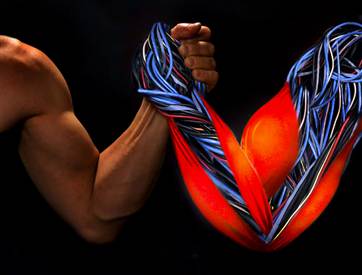Carbon Nanotube Muscles: 30 times stronger than human muscles!
 Researchers at Texas State University in Dallas, under the leadership of Ray Baughman, demonstrated a fundamentally new type of artificial muscles that can work at extreme temperatures — below the liquid nitrogen temperature (-196 ° C) and above the iron melting temperature (1538 ° C).
Researchers at Texas State University in Dallas, under the leadership of Ray Baughman, demonstrated a fundamentally new type of artificial muscles that can work at extreme temperatures — below the liquid nitrogen temperature (-196 ° C) and above the iron melting temperature (1538 ° C).These new artificial muscles can stretch 10 times more than natural muscles and 1000 times faster than natural muscles. In the other direction, in compression, they can generate thirty times more force than natural muscles having the same cross-sectional area. Natural muscles can be compressed by 20 percent per second, new artificial muscles can be compressed by an average of 30 thousand percent per second!
These artificial muscles are airgel sheets made of carbon nanotubes , created using a new solid-state technology developed at the university. Sometimes called frozen smoke, an airgel is a low-density solid-state material obtained from a gel in which the liquid component has been replaced by a gas. Airgel consists mainly of air. The starting material is an array of vertically aligned carbon nanotubes made by decomposition of hydrocarbons. Due to the special arrangement of these nanotubes, which are called wood (they look like a bamboo forest), carbon nanotubes can be formed into sheets. Sheets of such low density that an ounce will cover one acre!
( UPD: 1 oz ≈ 30 grams (28.3), 1 acre ≈ 4 thousand m² (≈ two-thirds of the football field)).
When voltage is applied to the airgel sheets of a carbon nanotube, the nanotubes repel each other in the way that muscle actually works. These transparent sheets have very unusual properties that are important for muscular work. For all that, they are as dense as air in one direction, they have a higher specific strength (strength / density) than a steel plate. In the other direction, they provide rubber stretchability.
')
Bogman and his colleagues even came up with the wording: Stronger steel, light as air and more flexible than rubber!
What are not the muscles of the 21st century? =)
via The University of Texas and Dallas , Physorg , Robots.net , Wired
Source: https://habr.com/ru/post/60493/
All Articles